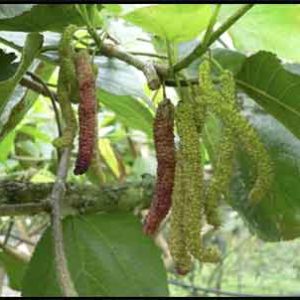Morus spp.
Mulberry
Origin
Three species are mainly cultivated; M. nigra, the black mulberry native to western Asia; M. alba, the white mulberry native to central and eastern China; and M. rubra, the red mulberry native to lowlands in eastern North America. All 3 species have now been widely distributed round the world.
Climate
They are widely adaptable to sub-tropical and temperate climates with each species having its own preferred range. Alba is the most cold hardy and nigra the least of the three. At the extremes, there are reports of some varieties being able to endure 50°C and others that can withstand -30°C. All require a low number of chill hours to bloom. They do not fare well in environments with humid summers.
Plant Description
A few varieties grow as a bush but most are trees, some large, and all are deciduous. The most common species in Australia is nigra, which is the smallest , <9m high. Leaves are alternate and variously lobed, even on the same plant. The common names red, black and white refer principally to leaf and wood characteristics and not the colour of the fruit, eg white mulberry fruit can be white, red or black. Rubra is the largest tree usually with large lobed dentate leaves. Alba and rubra are diploid while nigra is an extreme polyploid with 22 sets of chromosomes; it is also the latest to break dormancy in spring. Alba and rubra readily hybridise.
Relatives
Moraceae family: figs, jackfruit, breadfruit, che, etc.
Soils
They thrive in most soil types and levels of fertility such that in some countries they are classified as weeds. Good drainage and mildly acid conditions are preferred.
Propagation
Seeds are mainly used for variety improvement work as they’re slow to crop with variable fruit and sexually unstable while young. Cuttings are the main means of vegetative propagation. With ploidy differences between nigra and the others, graft incompatibility may result.
Most mulberry species will shoot readily from a cutting, taken in late winter or early spring, moistened in water for ten minutes, dipped in hormone powder and planted in outdoor potting mix in a pot. However, it is exceedingly difficult to persuade some species to grow roots.
Cultivars
Hicks Everbearing; Hicks Fancy; Johnson; Downing; Stubbs, best suited to warm districts; Black English, and the very long fruiting Black Persian, the red and white shahtoot (an alba hybrid sometimes called M. macroura).
Flowering and Pollination
Mulberries are either dioecious or monoecious and environmental factors may cause a change from one sex to the other. Inflorescences are short cylindrical yellowy-green catkins appearing in leaf axils of current season growth and on spurs of older wood. Pollination is by wind, but some varieties are apomictic.
Cultivation
They need a position in full sun. Black mulberries should not be planted where fallen fruit may stain pathways etc. To avoid fruit drop, plants should be watered when carrying fruit in extended dry periods. The need to fertilize is influenced by soil fertility and should be judged on leaf colour and vigour; if these are acceptable then none may be needed.
Wind Tolerance
This is reasonable and they are sometimes planted as windbreaks for other crops.
Pruning
Trees should be trained in an open vase formation when young to give 3-4 scaffold branches having wide crotch angles. Thereafter, pruning should be limited to removal of dead or crossing branches and containing tree size. Small, multistemmed trees are easy to manage: each year, remove the oldest trunk and allow a new one to replace it. The fruit is borne mainly on first-year wood, so by using the multi-trunk scheme, the tree undergoes partial renewal every year.
The Fruit
Fruit are an ovoid to cylindrical syncarp consisting of drupelets covered by a succulent calyx. Black mulberries generally have the best balance of sweetness and acidity. Fruit are very delicate and perishable meaning they do not transport well. Consequently they are more suited to private rather than commercial growing. Fruit contain good levels of iron, calcium and antioxidants and about 10% sugars.
Fruit Production and Harvesting
Cutting-grown trees can begin producing fruit within 2 years, but it may be 4-5 years before full cropping is achieved. With adequate water they can produce 25-40kg/tree/year. Fruit mature over a long period, necessitating multiple harvests. They should be fully tree-ripened for best flavour and hand-picked to avoid injury. They do not store well.
Fruit Uses
They are best eaten fresh but like other berries can be processed in many forms, eg pureeing, drying, jams, pies, tarts and puddings. Tea can be made from the leaves.
Pests and Diseases
Generally free of pests and diseases, but birds can be a problem.
Comments
Mulberries grow easily in our Mediterranean climate with their tolerance of dry periods and poor soils. They are precocious and give good yields of a fruit that is virtually unobtainable in retail outlets. A staggered harvest period means the famine/ feast phenomenon of some fruit tree species is minimised. Size containment will need to be managed.
The leaves of some species are used to feed silkworms. Mulberry trees are notorious for making a mess with dropped fruit and causing stains on skin and clothing. Mulberries are fire-retardant, so a row of mulberries as small trees or clipped into a hedge would make a useful bushfire screen. A mulberry tree also makes a good host for a quandong.
